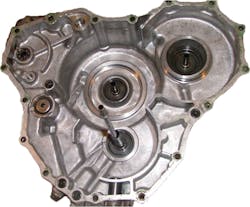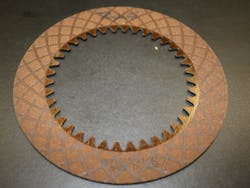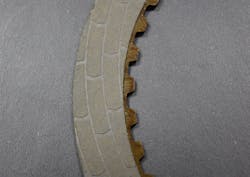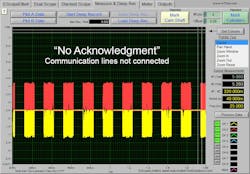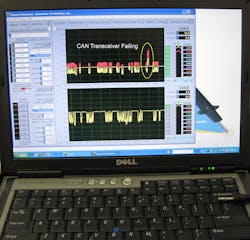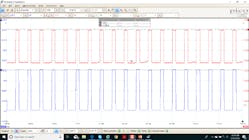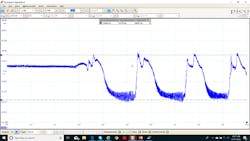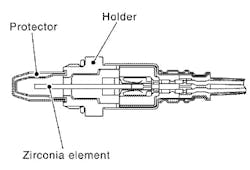Diagnosing modern transmissions accurately can be time consuming and messy. However, when charged out properly, diagnostics can be profitable and provide detailed proof regarding specific issues a unit might have. Informed technicians often are able to resolve these issues without an expensive rebuild or replacement of the transmission. It is worth noting, many re-manufacturers have reported a high percentage of units returned as cores that have minor problems and were erroneously replaced. In our example before us we will see how a little diagnostics both confirmed the customer’s complaint and reveals a repair considerably less expensive than a complete rebuild.
This Jetta presented itself as an interesting case study as it is a complaint we weren’t getting much of before this car rolled in. The customers concern was a no up shift into second gear only when cold. Once warmed up, it shifted just fine. Scan data revealed no codes even though the TCM was commanding a shift to occur (eventually the shift did happen, it was just quite delayed. Anywhere from two to five seconds). It would be easy to assume an internal sealing issue at this point as after it warmed up it shifted fine, kind of like we are used to seeing from the Mopar-style family transmissions with hard seals. Also the fluid looked particularly dark but does this mean it’s time for an overhaul as well? How can we confirm either a sealing issue or some other fault?
Obviously, a pressure test is going to be the best bet as to whether we have pressure building in the 2nd clutch pressure circuit. But, does little or no pressure mean a leak or something else? How should this pressure test be done? Personally, I feel a pressure test in the 21st century should be done with a lab scope and a pressure transducer. This will allow us to build a data base of good and bad pressures and also have physical proof to our customers that yes, we did pressure test your transmission and these are your results.
Another advantage of using a scope in our diagnosis is the ability to graph out over time other signals and commands that can impact the circuit being pressure tested be it mainline or a specific clutch tap. In this case we will watch 2nd clutch (2-4 brake clutch) pressure and shift solenoid commands. Figure 1 shows us the location of the pressure taps.
Determining which commands to watch along with pressure can be determined by looking at a clutch and solenoid application chart like the one seen in Figure 2 from ATSG’s Techtran™ Manual. On this trans, the second clutch is coming on with no other clutches turning off (not a transition shift). There is a shift solenoid turning off called the N92 by VW (usually referred to as Shift Solenoid C – figure 3) which even with the lack of a hydraulic diagrams being available we can assume is switching feed fluid to the second clutch circuit somehow, and a 2-4 brake PWM solenoid as well that is regulating the clutch apply.
Depending on your scope and hook up capabilities you can watch all or just a couple signals at a time. In this case, we are using a Pico 3423 series PC oscilloscope. I chose to start off with the 2-4 clutch pressure tap using the Pico wps500 pressure transducer. I also decided to watch both amperage and voltage to shift solenoid C, AKA N92. Why both? Voltage is a good way to watch the TCM's command but amperage lets us know if the solenoid is working. We will dissect those signals later.
Underneath the windshield wipers is the TCM with just enough room to hook up some probes. This is a far easier spot to get at compared to the main harness connecter at the trans!
Hitting the Road
With everything hooked up it's time for a test drive. When N92 turns off in Figure 4 (green trace voltage, yellow trace amperage) we don't see any pressure come up in the 2-4 clutch circuit (blue trace stays at 0 psi). Finally, a couple seconds later pressure does build and we feel the shift as well. Figure 5 shows the PSI rise seconds later in the blue trace. As the trans warms up this shift starts to happen sooner and sooner in relation to N92 turning off. Eventually it gets to the point that as soon as N92 goes off the shift is occurring as seen in Figure. 6.
At first, this could appear to be a sealing issue but I would expect the pressure to at least start to climb as soon as N92 goes off and maybe just stay low. A closer look at the voltage trace on N92 in Figure 5 again shows some sort of anomaly right before the pressure finally starts to rise in the circuit. This anomaly is consistent even as the shift starts to happen sooner and sooner.
The nice thing about a digital Oscilloscope is the ability to zoom in and look at detail of certain events. Zooming in on the voltage trace on Figure 7 we see a dip or a distortion in the waveform. How can this be since the circuit is and has been off?
For years our fellow techs who do drive ability work day in and day out have used current ramping and voltage traces in diagnosing fuel injectors and other emission related solenoids. Figure 8 shows an example of a fuel injectors pintle bumps in the blue voltage trace and the red current trace. While not every solenoid out there will show a pintle hump, (that is the movement of the pintle through the coil of the solenoid causing a change in the circuits inductance) most will show this and it can have tremendous diagnostic value as to whether or not a solenoid is physically capable of doing its job. Typically when a solenoid turns on you can see a pintle hump on the current ramp and when it turns off you can see something in the inductive kick of the voltage trace.
In our case of N92, the distortion in the voltage trace is the pintle moving through the coil winding and inducing a small voltage in the circuit. After we see that we then see the pressure rise in the circuit. A look at Figure 9 when N92 turns on will show a pintle hump on the current ramp but only after the solenoid has been un-stuck. During bench testing in Figure 10 this was very repeatable and it took quite a bit of shop air to un-stick the shift solenoid after pulling it out of the freezer. If I let it remain stuck and applied power to the solenoid, there was no pintle hump on the current ramp as seen in Figure 11.
In the end, this VW the young couple who owned it were very glad to not need a whole overhaul. In fact pulling the front end apart turns out to be a whole lot easier than a transmission R&R also (Figures 12 to 15). After replacing the shift solenoids the trans shifted perfect hot or cold every time.
Pressure testing can be very effective especially when synced with the proper signals that can affect the pressure at different times. Not all transmission problems mean its tear down time. Most customers probably expect that when they go to a transmission shop that that's what they will get, (and even some general repair shops may have condemned this unit as well), but a when a shop charges for a pin point diagnosis it can still make good money while the customer actually pays less for the overall repair. After all the most expensive transmission is the one you didn't really need.
I hope to share other examples of this in the future because as today’s transmissions get more and more complicated we are going to have to get more creative in how we are determining they are bad. Also as they are getting more expensive to replace so we may have to prove to our customers, and ourselves, why we need to do what we do.
Subscribe to Motor Age and receive articles like this every month…absolutely free. Click here
.jpg?auto=format,compress&fit=max&q=45&w=250&width=250)
.jpg?auto=format,compress&fit=max&q=45&w=250&width=250)
.jpg?auto=format,compress&fit=max&q=45&w=250&width=250)
.jpg?auto=format,compress&fit=max&q=45&w=250&width=250)
.jpg?auto=format,compress&fit=max&q=45&w=250&width=250)
